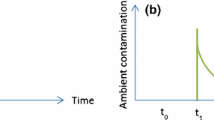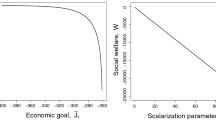Abstract
This paper concerns computational models in environmental economics andpolicy, particularly so-called integrated assessment models. For themost part, such models are simply extensions of standard neoclassicalgrowth models, extended by including the environment and pollutiongeneration. We review the structure of integrated assessment models,distinguishing between finite horizon and infinite horizon models, bothdeterministic and stochastic. We present a new solution algorithm forinfinite horizon integrated assessment models, relying on a neural netapproximation of the value function within an iterative version of theBellman equation.
Similar content being viewed by others
References
Blitzer, Charles R., Clark, Peter B. and Taylor, Lance (1975). Economy-Wide Models and Development Planning, World Bank, Washington, DC.
Cass, D. (1965). Optimum growth in aggregate model of capital accumulation. Review of Economic Studies, 32, 233–246.
Christiano, L. (1987). Is consumption insufficiently sensitive to innovations in income? American Economic Review Papers and Proceedings, 77, 337–341.
Christiano, L. (1988). Why does inventory investment fluctuate so much? Journal of Monetary Economics, 21, 247–280.
Christiano, L. and Eichenbaum, M. (1988). Is theory really ahead of measurement? Current real business cycle theories and aggregate labor market fluctuations. Technical Report 2700, National Bureau of Economic Research Working Paper.
Cooley, T. and Hansen, G. (1989). The inflation tax in a real business cycle model. American Economic Review, 79, 733–748.
Den Haan, W. J. and Marcet, A. (1990). Solving the stochastic growth model by parameterizing expectations. Journal of Business Economics and Statistics, 8(1), 99–113.
Dennis, J. (1977). Nonlinear least squares. In D. Jacobs (ed.), State of the Art in Numerical Analysis. Academic Pess, pp. 269–312.
Grossman, G. and Krueger, P. (1995). Economic growth and the environment. Quarterly Journal of Economics, 112.
Hansen, G. (1985). Indivisible labor and the business cycle. Journal of Monetary Economics, 16, 309–327.
Hansen, G. and Sargent, T. (1988). Straight time and overtime in equilibrium. Journal of Monetary Economics, 21, 281–308.
Judd, Kenneth L. (1991). Minimum weighted residual methods for solving dynamic economic models. Unpublished manuscript, Hoover Institution, Stanford University.
Kelly, David L. (1998a). On Kuznets curves arising from stock externalities. Mimeo, University Miami Economics Department.
Kelly, David L. (1998b). Convergence results for dynamic programming using neural networks. Mimeo, Department of Economics, University of Miami.
Kelly, David L. and Kolstad, Charles D. (2001). Malthus and climate: Betting on a stable population. Journal of Environmental Economics and Management, 41, 135–161.
Kelly, David L. and Kolstad, Charles D. (1999a). Bayesian learning, growth, and pollution. J. Econ. Dynamics and Control, 23(4), 491–518.
Kelly, David L. and Kolstad, Charles D. (1999b). Integrated assessment models for climate change control. In Henk Folmer and Tom Tietenberg (eds.), International Yearbook of Environmental and Resource Economics 1999/2000: A Survey of Current Issues. Edward Elgar, Cheltenham, U.K.
Kelly, David L., Kolstad, Charles D., Schlesinger, Michael E., and Andronova, Natalia G. (1998). Learning about climate sensitivity from the instrumental temperature record. Mimeo, UCSB Economics Department.
Kolstad, Charles D. (1993). Looking vs. leaping: The timing of CO2 control in the face of uncertainty and learning. In Y. Kaya, N. Nakicenovic, W.D. Nordhaus and F.L. Toth (eds.), Costs, Impacts and Benefits of CO2 Mitigation. IIASA, Austria, pp. 63–82.
Kolstad, Charles D. (1994). The timing of CO2 control in the face of uncertainty and learning. In E. van Ireland (ed.), International Environmental Economics. Elsevier, Amsterdam, Ch. 4.
Kolstad, Charles D. (1996). Learning and stock effects in environmental regulation: The case of greenhouse gas emissions. Journal of Environmental Economics and Management, 31, 1–18.
Koopmans, T.C. (1965). On the concept of optimal economic growth. In An Economic Approach to Development Planning. North Holland.
Kydland, F. and Prescott, E. (1982). Time to build and aggregate fluctuations. Econometrica, 50, 1345–1370.
Manne, A.S. and Richels, R.G. (1992). Buying Greenhouse Insurance: The Economic Costs of CO2 Emission Limits. MIT Press, Cambridge.
Manne, A.S., Mendelsohn, R. and Richels, R. (1995). A model for evaluating regional and global effects of GHG reduction policies. Energy Policy, 23, 17–34.
Meadows, D. et al. (1972). The Limits to Growth. Universe Books, New York.
Nordhaus, W.D. (1994). Managing the Global Commons: The Economics of Climate Change. MIT Press, Cambridge, Mass.
Nordhaus, W.D. and Yang, Z. (1996). A regional dynamic general-equilibrium model of alternative climate-change strategies. American Economic Review, 86, 741–765.
Peck, S.C., Chao, H.P. and Teisberg, T.J. (1989). Optimal control and learning strategies when environmental costs are cumulative. Proc. IFAC/IFORS/IAEE International Symposium on Energy Systems, Management and Economics, Oct. 25–27, Tokyo.
Peck, S.C. and Teisberg, T.J. (1992). CETA: A model for carbon emissions trajectory assessment. Energy Journal, 13(1), 55–77.
Peck, S.C. and Teisberg, T.J. (1993). Global warming uncertainties and the value of information: An analysis using CETA. Resource and Energy Economics, 15, 71–98.
Ramsey, Frank (1928). A mathemtical theory of saving. Economic Journal, 38, 543–559.
Stokey, Nancy L. and Lucas, Robert E. Jr. (1989). Recursive Methods in Economic Dynamics. Harvard, Cambridge, Mass.
Trick, M. and Zin, S. (1993). A linear programming approach to solving stochastic dynamic programs. Mimeo, Carnegie Mellon University.
Trick, M. and Zin, S. (1995). Adaptive spline generation: A new algorithm for solving stochastic dynamic programs. Mimeo, Carnegie Mellon University.
Weyant, J.P. et al. (1996). Integrated assessment of climate change: An overview and comparison of approaches and results. In J.P. Bruce et al. (eds.), Climate Change 1995: Economic and Social Dimensions of Climate Change. Cambridge University Press, Cambridge, pp. 367–439.
White, H. (1992). Artificial Neural Networks. Blackwell Publishers, Cambridge, Mass.
Author information
Authors and Affiliations
Rights and permissions
About this article
Cite this article
Kelly, D.L., Kolstad, C.D. Solving Infinite Horizon Growth Models with an Environmental Sector. Computational Economics 18, 217–231 (2001). https://doi.org/10.1023/A:1021018417052
Issue Date:
DOI: https://doi.org/10.1023/A:1021018417052




